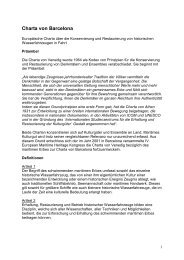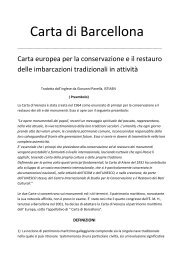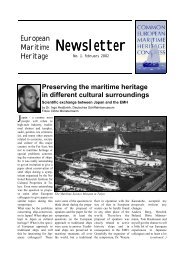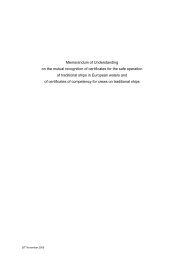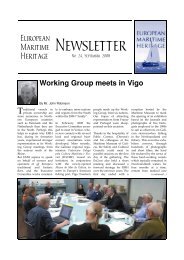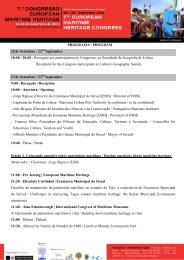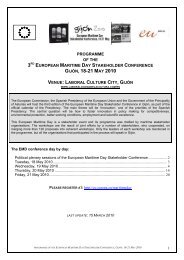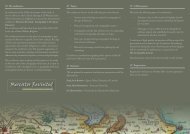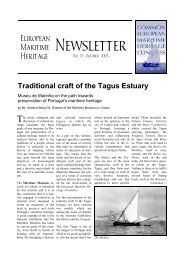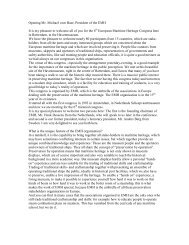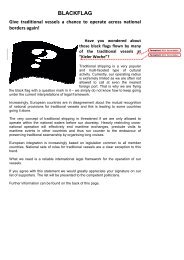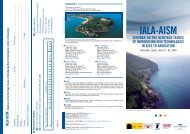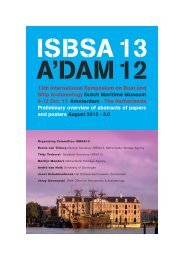general presentation - European Maritime Heritage EMH
general presentation - European Maritime Heritage EMH
general presentation - European Maritime Heritage EMH
You also want an ePaper? Increase the reach of your titles
YUMPU automatically turns print PDFs into web optimized ePapers that Google loves.
The <strong>European</strong> Association for<br />
Traditional Ships in Operation
Today´s program<br />
The program<br />
• General introduction of <strong>EMH</strong><br />
• Quiz<br />
• <strong>EMH</strong> philosophy<br />
• National <strong>presentation</strong>s<br />
• Review JWG proposal<br />
• Closing remarks and questions
The <strong>European</strong> Peninsula
National members: 8<br />
Denmark<br />
Finland<br />
France<br />
Germany<br />
Netherlands<br />
Norway<br />
Sweden<br />
United Kingdom<br />
Greece (expected)<br />
Regional members: 1<br />
Galicia, Spain<br />
Flanders (expected)<br />
<strong>EMH</strong> membership
Advisory members: 19<br />
Museums and boat centres<br />
M<br />
M<br />
M<br />
<strong>EMH</strong> membership<br />
M<br />
M<br />
M<br />
M M M<br />
M<br />
M<br />
M M<br />
M<br />
M<br />
M<br />
M<br />
M<br />
M<br />
Antwerpen, BE<br />
Rudkøbing, DK<br />
Barcelona, ES<br />
San Sebastian, ES<br />
Helsinki, FI<br />
Paris, FR<br />
Bremerhaven, GE<br />
Amsterdam, NL<br />
Enkhuizen, NL<br />
Rotterdam, NL<br />
Kristiansand, NO<br />
Norheimsund, NO<br />
Gratangen, NO<br />
Greenwich, UK<br />
Seixal, PT<br />
Lisbon,PT<br />
Karlskrona, SE<br />
Klaipeda, LT<br />
Rovinj,HR
Associate members: 11<br />
<strong>EMH</strong> membership<br />
International Council <strong>Maritime</strong> Museums (ICMM)<br />
Sail Training International (STI)<br />
Baltic Sail / Hanse Sail Rostock<br />
Sammenslutningen af Mindre Erhvervfartöjer (SME), DK<br />
Estonian Association of Historical Ships, EE<br />
Forbundet Kysten, NO<br />
Portuguese Association for <strong>Maritime</strong> <strong>Heritage</strong> (APMM), PT<br />
STS General Zaruski, Gdansk, PL<br />
Goelette Grosse-Île, Montreal, Canada<br />
Albaola - Basque <strong>Maritime</strong> <strong>Heritage</strong> Society, ES<br />
Islandic Association of <strong>Maritime</strong> Museums
<strong>EMH</strong> is member of<br />
International Congress of <strong>Maritime</strong> Museums:<br />
Umbrella of <strong>Maritime</strong> Museums in the World<br />
Europa Nostra:<br />
The voice of Cultural <strong>Heritage</strong> in Europe<br />
Association of <strong>Maritime</strong> Museums in the Mediterranean
Events<br />
More than 500 events attract<br />
20 millions spectators a year
Recommendation<br />
The Parliamentary Assembly for the Council of<br />
Europe (PACE) Recommendation No 1468/2000<br />
Preserve, use, educate, joy and safe operation
MoU<br />
A Memorandum of Understanding<br />
for Traditional Ships signed by<br />
Norway United Kingdom Spain<br />
Finland Netherlands Germany<br />
Denmark Estonia Sweden
Barcelona Charter<br />
Guideline for proper<br />
• conservation<br />
• preservation<br />
of ships in operation and skills
Future Policy<br />
<strong>EMH</strong> foresees a bright future for <strong>European</strong><br />
<strong>Maritime</strong> <strong>Heritage</strong> with support,<br />
collaboration and a progressive policy
<strong>EMH</strong> offers<br />
<strong>Maritime</strong> <strong>Heritage</strong> is an economic factor<br />
• 20 Million spectators spend € 25 per day and<br />
generate € 500 Million income for local tourism<br />
• 10000 ships in operation spending € 25.000 in<br />
maintenance and operating do generate € 250 Million<br />
turnover for related craftsmen and suppliers
<strong>EMH</strong> offers<br />
• Creates awareness for the common <strong>European</strong> maritime<br />
roots<br />
• Creates awareness of a common <strong>European</strong> identity<br />
• Facilitates tourism development of regions
<strong>EMH</strong> offer<br />
• Offers training in social skills and team spirit<br />
• Preserves maritime skills and craftsmanship, which<br />
otherwise might get lost<br />
• Will generate thousands of motivated future officers and<br />
seafarers for Europe’s merchant marine, ports, administrations<br />
and shipping companies
Economic calculation volunteers<br />
10.000 ships x 10 persons x 10 days x € 100 / day =<br />
€ 100.000.000 (100 million euros )
Europe’s <strong>Maritime</strong> Future is founded on<br />
Europe’s <strong>Maritime</strong> <strong>Heritage</strong><br />
www.e-m-h.eu
Aphrodite<br />
Built ?<br />
Original function?<br />
Traditional?<br />
Traditional ships in operation<br />
Artemis<br />
Built ?<br />
Original function?<br />
Traditional?
Astrid<br />
Built ?<br />
Original function?<br />
Traditional<br />
Traditional ships in operation<br />
Bruinvisch<br />
Built ?<br />
Original function?<br />
Traditional
Europa<br />
Built ?<br />
Original function?<br />
Traditional<br />
Traditional ships in operation<br />
Hydrograaf<br />
Built ?<br />
Original function?<br />
Traditional
Kaatje<br />
Built ?<br />
Original function?<br />
Traditional<br />
Traditional ships in operation<br />
Oosterschelde<br />
Built ?<br />
Original function?<br />
Traditional
Souverein<br />
Built ?<br />
Original function?<br />
Traditional<br />
Traditional ships in operation<br />
Zuiderzee<br />
Built ?<br />
Original function?<br />
Traditional
Traditional ships in operation<br />
Aphrodite<br />
Built: 1994<br />
Original function: Sailing passenger ship<br />
Traditional ?<br />
Artemis<br />
Built : 1926<br />
Original function: Whale hunter<br />
Traditional ?
Astrid<br />
Built : 1918<br />
Original function: Herring lugger<br />
Traditional ?<br />
Traditional ships in operation<br />
Bruinvisch<br />
Built : 1902<br />
Original function: cargo tjalk<br />
Traditional ?
Europa<br />
Built : 1911<br />
Original function: Light vessel<br />
Traditional ?<br />
Traditional ships in operation<br />
Hydrograaf<br />
Built : 1910<br />
Original function: Hydrographic survey vessel<br />
Traditional ?
Kaatje<br />
Built : 1785/1935<br />
Original function: Stationary<br />
training vessel<br />
Traditional ?<br />
Traditional ships in operation<br />
Oosterschelde<br />
Built : 1917<br />
Original function: Three mast schooner<br />
Traditional ?
Souverein<br />
Built : 1956<br />
Original function: oil tanker<br />
Traditional: ?<br />
Traditional ships in operation<br />
Zuiderzee<br />
Built : 1909<br />
Original function: Two mast schooner<br />
Traditional ?
Chapter 19<br />
Keeping traditional ships in operation<br />
• To safeguard the ships<br />
• To safeguard the seamanship and the<br />
craftsmanship<br />
but also<br />
• No economic value, no upkeep<br />
• Participation in regular inland navigation
Philosophy<br />
SAFETY COMMERCE<br />
CULTURE
Definition<br />
Memorandum of Understanding, Wilhelmshaven 2000<br />
“historic ships” can be all kinds of historical ships and their replicas<br />
including those designed to encourage and promote traditional skills and<br />
seamanship, that together serve as living cultural monuments, operated<br />
according to traditional principles of seamanship and technique.<br />
GSHW<br />
Historic ship is a ship or its replica for which’s preservation and operation<br />
the society has an interest; especially because of its age, its special<br />
technical and/or constructive character, its rareness, its importance for<br />
the conservation and instruction of the historic principles of seamanship<br />
and/or technical knowledge of inland navigation or its importance for its<br />
period in history and/or its region.
Definition 2<br />
Herr Kliche, JWG (07)55, 22 October 2007<br />
The Recommendation 1486 takes notice of the already existing public<br />
interest in these non-monuments and exactly does not ask to make them<br />
monuments, but to support and encourage public and private bodies and<br />
voluntary associations which preserve historic vessels, or life size or<br />
large scale replicas, in working order; and encourage the display and<br />
use of these vessels for the education and enjoyment of the <strong>general</strong><br />
public<br />
A traditional ship, which is build as a passenger ship, shows in its<br />
individual plan of operation essential information of itself, of its operation<br />
and its decoration (and/or of national or regional historic events or<br />
aspects) and will not only be preserved and operated just for the<br />
enjoyment of the guests or for the most universal employability
Barcelona Charter<br />
Definition 3<br />
ARTICLE 1.<br />
The concept of maritime heritage afloat embraces the single traditional<br />
ship in which is found the evidence of a particular civilisation or<br />
significant development as well as traditional sailing, seamanship and<br />
maritime workmanship. This applies both to larger ships and to more<br />
modest craft of the past, which have acquired cultural significance with<br />
the passing of time.<br />
ARTICLE 2.<br />
The preservation, restoration and operation of traditional ships must<br />
have recourse to all the sciences, techniques and facilities, that can<br />
contribute to the study and safeguarding of the<br />
maritime heritage afloat.
EG2002/59<br />
Definition 4<br />
traditional ships means all kinds of historical ships and their<br />
replicas including those designed to encourage and<br />
promote traditional skills and seamanship, that together serve as<br />
living cultural monuments, operated according to<br />
traditional principles of seamanship and technique;
Value setting framework<br />
Taxation of cultural values<br />
1. The meaning of the object.<br />
2. Comparative criteria for weighing of the<br />
cultural meaning and to establish the<br />
uniqueness of the object.<br />
3. Plan for preservation and restoration,<br />
including which values especially have to<br />
be saved.
Value setting framework<br />
1. The meaning of the object.<br />
This is a <strong>general</strong> description of not only the object<br />
itself but also the history of its use.<br />
- Historic meaning in all its forms, for example<br />
Scientific or technical meaning<br />
Social-economic meaning<br />
- Aesthetic meaning (sensory aspects: we love to<br />
see it, we like the smell of coal and enjoy the<br />
sound of the steam whistle)<br />
- Social or actual meaning
Value setting framework<br />
2. Comparative criteria for weighing of the cultural<br />
meaning and to establish the uniqueness of the object<br />
-Re<strong>presentation</strong> meaning<br />
- calibration value<br />
- symbolic value<br />
- link value<br />
- origin or cultural biography<br />
- Rarity<br />
- Actual status of the object<br />
- conceptual authenticity<br />
- material authenticity<br />
- non-historic authenticity<br />
- the historic period chosen to demonstrate<br />
- historic authenticity<br />
- functional authenticity<br />
- Presentation potential<br />
- Ensemble value<br />
- Documentation available<br />
- Knowledge
Value setting framework<br />
3. Plan for preservation and restoration,<br />
including which values especially have to be<br />
saved.<br />
The majority of maritime heritage is in operation, sometimes even to<br />
provide means for maintenance. This makes it necessary to draft the<br />
plan of operation.
Replicas
Replicas
Spirit of tradition
Restoration projects
New function, new certificate
Main conversion
Main conversion
The <strong>European</strong> Peninsula<br />
The <strong>European</strong> Peninsula is connected by<br />
transport over the sea and the inland waterways<br />
Chapter 19 could recognise traditional shipping<br />
and its <strong>European</strong> origin and orientation<br />
The variety and number of current and future<br />
traditional ships call for a generic solution
Europe’s <strong>Maritime</strong> Future is founded on<br />
Europe’s <strong>Maritime</strong> <strong>Heritage</strong><br />
Any questions?<br />
Thank you very much for your<br />
attention



